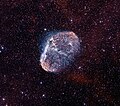| Emission nebula | |
|---|---|
 The Crescent Nebula, captured with a color camera, narrowband filter, and high-speed amateur telescope | |
| Observation data: J2000.0 epoch | |
| Right ascension | 20h 12m 7s [1] |
| Declination | +38° 21.3′ [1] |
| Distance | 5,000 ly |
| Apparent magnitude (V) | +7.4 |
| Apparent dimensions (V) | 18′ × 12′ |
| Constellation | Cygnus |
| Designations | NGC 6888, [1] Sharpless 105, Caldwell 27 |
The Crescent Nebula (also known as NGC 6888, Caldwell 27, Sharpless 105) is an emission nebula in the constellation Cygnus, about 5000 light-years away from Earth. It was discovered by William Herschel in 1792. [2] It is formed by the fast stellar wind from the Wolf-Rayet star WR 136 (HD 192163) colliding with and energizing the slower moving wind ejected by the star when it became a red giant around 250,000 years ago [3] . The result of the collision is a shell and two shock waves, one moving outward and one moving inward. The inward moving shock wave heats the stellar wind to X-ray-emitting temperatures.







